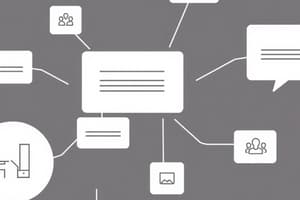Podcast
Questions and Answers
What is a key benefit of challenging assumptions in Design Thinking?
What is a key benefit of challenging assumptions in Design Thinking?
- It decreases the need for user involvement.
- It helps uncover hidden opportunities. (correct)
- It enhances habitual thinking.
- It simplifies the design process.
What is the primary focus of the Empathize stage in Design Thinking?
What is the primary focus of the Empathize stage in Design Thinking?
- To understand the user's needs and experiences. (correct)
- To brainstorm innovative ideas.
- To create prototypes for testing.
- To define the core problem statement.
Which of the following describes an effective problem statement?
Which of the following describes an effective problem statement?
- Technical and detailed for designers.
- Vague and broad to cover more ground.
- User-centered, clear, and actionable. (correct)
- Focused only on business objectives.
Which activity is specifically associated with the Ideate stage of Design Thinking?
Which activity is specifically associated with the Ideate stage of Design Thinking?
What is one method used during brainstorming in the Ideate stage?
What is one method used during brainstorming in the Ideate stage?
Why is collaboration considered a core principle of Design Thinking?
Why is collaboration considered a core principle of Design Thinking?
During which stage of Design Thinking do users test a prototype and provide feedback?
During which stage of Design Thinking do users test a prototype and provide feedback?
What role do user personas play in the Design Thinking process?
What role do user personas play in the Design Thinking process?
How does experimentation fit into the Design Thinking process?
How does experimentation fit into the Design Thinking process?
What is one principle of Design Thinking that focuses on understanding the user?
What is one principle of Design Thinking that focuses on understanding the user?
What is the primary purpose of low-fidelity prototypes?
What is the primary purpose of low-fidelity prototypes?
Which of the following describes high-fidelity prototypes?
Which of the following describes high-fidelity prototypes?
What is the first step in the prototyping process after creating a prototype?
What is the first step in the prototyping process after creating a prototype?
How does Design Thinking impact innovation?
How does Design Thinking impact innovation?
Which principle is emphasized in IBM's Design Thinking framework?
Which principle is emphasized in IBM's Design Thinking framework?
What role does iteration play in the design thinking process?
What role does iteration play in the design thinking process?
Which of the following is NOT mentioned as a mindset essential for design thinking?
Which of the following is NOT mentioned as a mindset essential for design thinking?
What contributes to the effectiveness of a design thinking process?
What contributes to the effectiveness of a design thinking process?
Which of these best captures the iterative nature of design thinking?
Which of these best captures the iterative nature of design thinking?
What is a common outcome of user testing prototypes?
What is a common outcome of user testing prototypes?
Flashcards
What is Design Thinking?
What is Design Thinking?
A human-centered approach to innovation that focuses on understanding user needs, challenging assumptions, and creating innovative solutions.
Why is Challenging Assumptions Important?
Why is Challenging Assumptions Important?
This principle helps break down habitual thinking and encourages new ideas, allowing you to avoid biases and discover hidden opportunities.
What are the Core Principles of Design Thinking?
What are the Core Principles of Design Thinking?
The core principles of Design Thinking are empathy, collaboration, and experimentation.
What is the Empathize Stage?
What is the Empathize Stage?
Signup and view all the flashcards
What is the Define Stage?
What is the Define Stage?
Signup and view all the flashcards
What is the Ideate Stage?
What is the Ideate Stage?
Signup and view all the flashcards
What is the Prototype Stage?
What is the Prototype Stage?
Signup and view all the flashcards
What is the Test Stage?
What is the Test Stage?
Signup and view all the flashcards
What is a User Persona?
What is a User Persona?
Signup and view all the flashcards
What is the SCAMPER Technique?
What is the SCAMPER Technique?
Signup and view all the flashcards
Low-fidelity Prototypes
Low-fidelity Prototypes
Signup and view all the flashcards
High-fidelity Prototypes
High-fidelity Prototypes
Signup and view all the flashcards
Prototyping
Prototyping
Signup and view all the flashcards
Design Thinking
Design Thinking
Signup and view all the flashcards
Problem Decomposition
Problem Decomposition
Signup and view all the flashcards
Iterative Process
Iterative Process
Signup and view all the flashcards
User-Centered Design
User-Centered Design
Signup and view all the flashcards
Collaborative Design
Collaborative Design
Signup and view all the flashcards
Experimentation in Design
Experimentation in Design
Signup and view all the flashcards
IBM's Design Thinking Framework
IBM's Design Thinking Framework
Signup and view all the flashcards
Study Notes
Design Thinking for Startups and Innovation
- Design Thinking is a human-centered approach to innovation focused on understanding user needs, challenging assumptions, and redefining problems to create innovative solutions.
Core Principles of Design Thinking
- Empathy: Understanding user needs.
- Collaboration: Working with diverse teams to solve problems.
- Experimentation: Prototyping and testing solutions early and often.
The Five Stages of Design Thinking
- Empathize: Understand user needs through interviews, observations, surveys, and user personas.
- Define: Clearly define the problem based on insights from the empathize stage.
- Ideate: Brainstorm creative solutions using techniques like brainstorming, mind mapping, and SCAMPER.
- Prototype: Develop a simple, tangible version of the solution; use low-fidelity (sketches, mockups) and high-fidelity (clickable wireframes) prototypes.
- Test: Test the prototype with real users to gather feedback and iterate based on feedback to improve the solution.
Design Thinking as a Tool for Innovation
- Encourages creative problem-solving by challenging assumptions and focusing on user needs.
- Breaks down complex problems into manageable, actionable steps.
- Promotes a flexible, iterative process that allows for continual improvement and adaptation.
IBM's Design Thinking Journey
- IBM has integrated design thinking into its processes to enhance user experience and drive innovation.
- Emphasizes a user-centered approach and collaborative practices to achieve effective design outcomes.
- Core Principles: User-centered design, emphasizing empathy for users and their needs.
- Iterative Process: Highlights the importance of iterating designs based on feedback, continuous testing, and design refinement.
- Cross-Disciplinary Collaboration: Encourages collaboration across different teams and disciplines to bring diverse perspectives into the design process.
- Mindsets: User-centered design, collaborative teamwork, encouraging a culture of experimentation and learning from failure.
- Focus on Outcomes: The emphasis is on delivering outcomes that provide value to users and drive business success.
- Tools and Techniques: Empathy maps, journey maps, and prototypes to aid in understanding user needs and testing ideas.
Case Studies
- Apple: Focused on intuitive design and user experience.
- Airbnb: Solved the problem of high accommodation costs with a user-centric platform.
Group Activity: Applying Design Thinking
- Empathize: Identify target users.
- Define: Define the specific problem.
- Ideate: Brainstorm solutions.
- Prototype: Develop a prototype.
- Test: Present the solution and gather feedback.
Studying That Suits You
Use AI to generate personalized quizzes and flashcards to suit your learning preferences.




